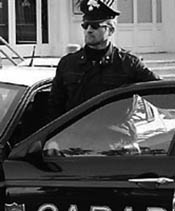Fraud, Italian style
 Last summer, some Italian police were trained as sommeliers. They have been kept busy.
Last summer, some Italian police were trained as sommeliers. They have been kept busy.
First, 600,000 bottles of Brunello di Montalcino from Castello Banfi have been impounded because the wine, which should be 100% sangiovese, may have had other grape varieties blended in. Not a big deal, really, but it is in contravention of the Brunello di Montalcino standards.
Now, thanks to a tip from Gabrio, I’ve learned that there is another, more serious adulteration scandal affecting 70 million liters of Italian wine. According to this poorly translated page from L’espresso, fertilizers, hydrochloric acid, sulphuric acid and maybe more have been found in some low-end wines in Italy. The perpetrators cooked up the “hellish cocktail,” apparently, in an attempt to stretch wine by adding water and sugar. Then they used the industrial acids to break the sucrose (sugar) down into glucose and fructose, which are allowable and prevented detection. Yikes. L’espresso calls it “the largest food adulteration ever discovered in Italy.”
Gabrio writes “This is a serious problem that can damage the Italian wines image like the ethanol scandal that happened 22 years ago…That is the reason why I stay away from the mass produced wines.”
Do you think Italy has more fraud than other countries? Or are the authorities just better at sniffing it out?




On April 4th, 2008 at 12:18 pm ,Gabrio Tosti wrote:
The difference is that in Europe there are laws that regulate the winemaking process. These laws allow the law enforcement to investigate and sometimes catch the perpetrators. Chile Australia to a certain extend USA and many other countries do not have rules therefore no need to look for adulteration. I have a question for you; how much must you think is in Yellow Tail?
On April 4th, 2008 at 12:58 pm ,Morton Leslie wrote:
Every country and every growing region has their cheaters, but the Italians seem to engage in it more. Thankfully, most of the cheating is giving the consumer a cheaper and lower quality product than the label indicates. Even when they are caught they come back with a new scam. And often we celebrate them.
Like when Fred Franzia was banned from the wine business for five years and fined several million dollars for making White Zin from Thompson. He came back with the idea of moving his bottling to just inside Napa County boundaries, buying up defunct Napa brands, putting California wine in them, and continue to mis-lead with the words Napa on the label. Someone recently voted him winemaker of the year. Maybe Banfi is next.
On April 5th, 2008 at 6:40 am ,Bisso wrote:
Guys, the L’Espresso article speaks about wines that are sold for 0,70 to 2,00 euros (shelf-price) IN Italy. This can hardly go to export as it won’t pass export control. Why are you so occupied with what mean italians drink? After all wine is not pure chemistry as ****-Cola or wheatever, if you think that you can buy normal wine for a dollar it’s purely your choice to poison yourself.
I’m just out of a press-conference of Vinitaly’s president Luigi Castelletti here at Veronafiere who said that he is going to sue L’Espresso for staining the good name of Vinitaly (becuase of the magazine cover with the word Velenitaly, meaning something like “venomitaly”).
On April 6th, 2008 at 11:19 am ,Tim wrote:
Yikes! Adulteration is something I often wonder about but without more regulation—or setting up my own chemistry lab and getting a degree to know how to use it—there’s no way to really know what’s done before wine goes into the bottle.
On April 6th, 2008 at 11:44 am ,bobby arifi wrote:
Owning a restaurant, I can tell you fraud is a definate problem. I have a vast number of people offering to sell wines from their “private collection” I as a rule refuse to buy wines from private collections for a number of reasons. the most important being, chain of command. They have to provide documentation, then it has to be verified and then I have to make sure the wine have been properly stored. It’s easy to say I have screaming eagle. (yes there are copies out there). but the easiest way to verify is to call the winery. In most cases, once you tell them you will call the winery to verify they go away.
Let’s not forget, the Tuscans making cheap chianti’s with Nero di Avolo grapes, not so long ago,
At the end of the day buyer beware, with so many great wines out there, spend the extra money and buy wines from a trusted source. That is the best protection against fraud.
On April 9th, 2008 at 10:50 am ,Chuck wrote:
Good on them for training officers. It’s funny how wine is treated so differently [so loosely] than other beverages, and foods for that matter.